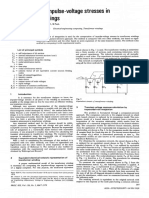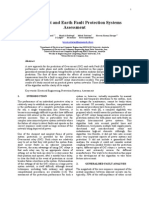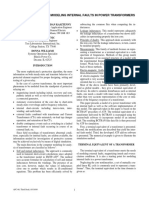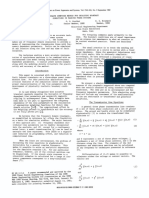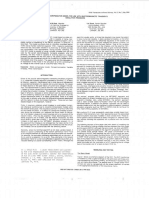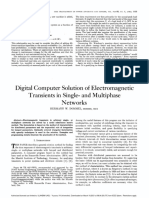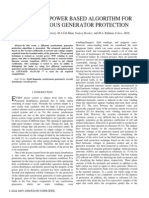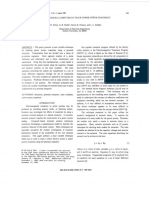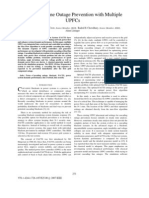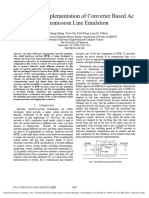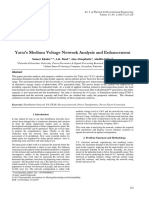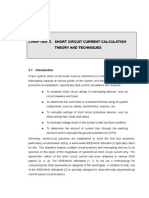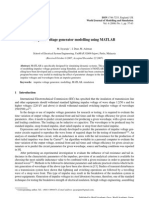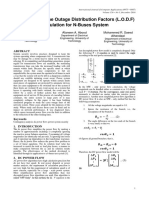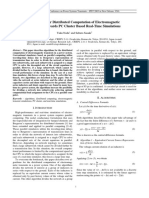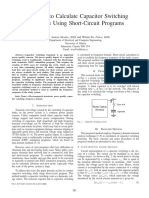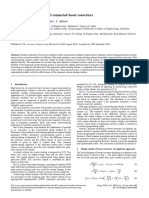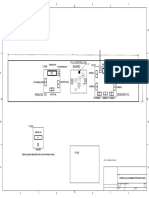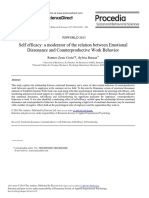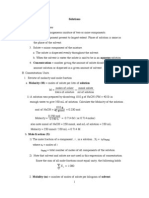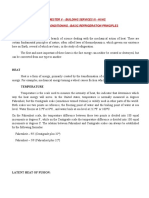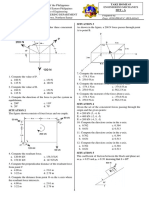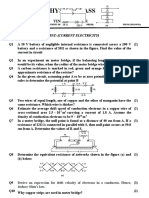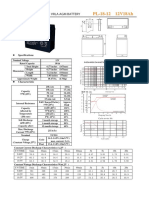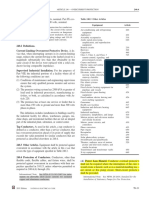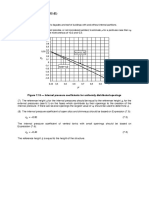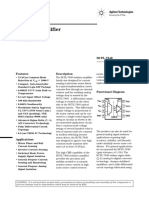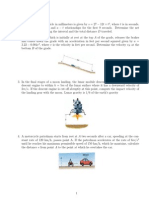Transient Short Circuit Current Calculation Using Decoupled Networks
Transient Short Circuit Current Calculation Using Decoupled Networks
Uploaded by
Padmo PadmundonoCopyright:
Available Formats
Transient Short Circuit Current Calculation Using Decoupled Networks
Transient Short Circuit Current Calculation Using Decoupled Networks
Uploaded by
Padmo PadmundonoOriginal Description:
Original Title
Copyright
Available Formats
Share this document
Did you find this document useful?
Is this content inappropriate?
Copyright:
Available Formats
Transient Short Circuit Current Calculation Using Decoupled Networks
Transient Short Circuit Current Calculation Using Decoupled Networks
Uploaded by
Padmo PadmundonoCopyright:
Available Formats
1110 IEEE Transactions on Power Delivery, Vol. 14,No.
3, July 1999
Transient Short Circuit Current Calculation using Decoupled Networks
P. J. LagacC
L. A. Dessaint J. Mahseredjian A. Chartrand
M. Lavoie
Ecole de Technologie Superieure Hydro-Quebec (iREQ) Hydro-Quebec
1 100 rue Notre-Dame Ouest 1800Boul. Lionel-Boulet Complexe Desjardms, CP 10000
MontrCal, QuCbec, Canada H3C 1K3 Varennes, Quebec, Canada J3X 1S1 Montrdal, Qudbec, Canada H5B 1H7
ABSTRACT Classical fault analysis methods for power sys- algorithm can handle single or multiple fault cases by apply-
tems are based on symmetrical components to represent vari- ing superposition in the final calculation of vrn.
ous fault configurations. The complete electrical network is With increased speed and memory capacity of modern
decomposed using a complex transformation matrix into computers, research efforts in the area of short-circuit analysis
decoupled zero, positive and negative sequence circuits. have continued beyond the conventional system modeling
Faulted power system steady-state voltages and currents are approach. Equivalent nonlinear impedance characteristics
computed using a nodal analysis solution method. have been developed to determine the effect of varistors on
This paper presents an extension of the above methodol- the short-circuit current fundamental component [3]. The
ogy using discretized RLC elements for the computation of effect of unbalanced nonlinear impedance on the steady-state
the actual transient response of a network for various fault fault current has been evaluated by implementing an iterative
types. The decoupled networks are obtained using a real trans- solution procedure with shunt current injection in the
formation matrix. sequence networks [4]. The combination of time and fie-
quency domain techniques has been developed to include
Keywords: Short-circuit currents, transients, fault analysis combinations of constant impedance, current and power load
models [5]. Conventional short-circuit methodology has been
combined with power-flow solutions allowing the consider-
1. INTRODUCTION ation of steady-state unbalanced system conditions [6].
Recently artificial neural networks have been used for detec-
A short-circuit program is a useful and basic power system ting fault induced high frequency noise [7].
analysis tool. Traditional short-circuit calculations are per- The present approach is to estimate the maximum asym-
formed using symmetrical components [1][2]. A three-phase metrical short-circuit current from the symmetrical short-cir-
network of arbitrary topology is decomposed into decoupled cuit current using the Xm method and assuming exponential
zero, positive and negative sequence networks using a com- decay behavior of fault current contributions typical for first
plex transformation matrix. A common approach is to write order circuits [SI. For higher order circuits found in series
sequence network equations through nodal analysis formula- compensated networks, exponential decay behavior alone is
tion: Y,V,=Im for the sequence counter m = 0,1,2. yrnis not sufficient to represent transients and an alternate method
the complex admittance matrix, V, is the complex vector of must be used. In a continuous effort to extend the range of
unknown node voltages and I, is the complex vector of applicability of the commonly used short-circuit software, this
known nodal current injections. The pre-fault sequence volt- paper proposes to implement a new approach based on numer-
ages and currents are found from a typical load-flow solution. ical integration and related to EMTP [9] type simulations.
The sequence network equations are used to compute the fault
impedances (Zo, Z, and Z2) at fault location required with
pre-fault voltages in the solution of fault current equations. 2. NETWORK EQUATIONS
The sequence network equations are reused in the computa-
tion of the faulted network steady-state solution. This type of Since symmetrical components involve complex coeffi-
cients, their use is not well suited for time-domain computa-
PE-307-pwRD-O-08-1998 A paper recommended and approved by tions where all quantities are real. It is chosen to create
the IEEE Transmission and Distribution Committee of the IEEE Power decoupled circuits using a , p and 0 components which are
Engineering Society for publication in the IEEE Transactions on Power
Delivery. Manuscript submitted December 29,1997; made available for
related to phase quantities as follows [ 101:
printingAugust 14, 1998. Vabc = T V O ~ P (1)
which is :
0885-8977/99/$10.00 0 1998 IEEE
1111
Transformation from phase quantities is given by: any network node.
VOaP = T' vabc (3)
Bold characters are used to distinguish vectors and matrices.
3. FAULT EQUATIONS
Similar equations are written for relating currents i h and
ioab. This transformation is used in both fiequency domain The three decoupled fault circuits seen at a fault bus are
and time-domain to create 3 decoupled networks from a 3- presented P Fig. 2. The subscript F is used to denote the fault
phase system. terminal. V,F(t) is the Thevenin voltage contributed by the
To achieve a time-domain nodal solution, real parameters steady-state solution, R,F is the Thevenin resistance,
are needed as network data and a discretized model equivalent i,W(t-At) is contribution from history current sources in
must be evaluated for all RLC components of the network. A the transient response, VmF(t) is the fault branch voltage and
generic discrete equivalent for the RLC branch at time t is i,F(t) is the fault current. If there is no fault current injected
shown in Fig. 1. The current source is a history term evaluated in a given circuit then the corresponding history
at the previous time-point (t - At ). It is chosen to program i,w(t -At) is zero.
trapezoidal integration for stability and precision and to use
halved time-step (At / 2 ) Euler-backward for calculating ini-
tial conditions for all state variables and to avoid numerical
oscillations at switching instants [ll].
It is recalled that the equivalent resistance equation
,R = R + 2L / At + At / (2C) is the same for both integration
methods, but the history current equation in trapezoidal inte-
gration [9]:
ih(t-At)= (A\
\-/
2 v ~ (-t At) - v(t - At) +
is different from the Euler-backward
At
ih(t--)=2 (5)
ipF(t)
Figure 2: Decoupled fault circuits seen at the fault bus
These circuits can be used to compute fault currents for
- arbitrary fault conditions, some typical cases are presented
Figure 1: A discretiid RLC branch component below. It is noticed that in addition to standard fault configura-
tions the undertaken methodology allows formulating equa-
When all network components are given the representation tions for series-fault conditions such as the one-conductor-
of Fig. 1, a set of 3 decoupled nodal analysis equations can be open or two-conductors-open cases.
written:
Ymvm = i, m = O,a,P (6) 3.a Sinele-line-to-mound fault
The right hand side current vectors are constructed from his-
C O 0
tory term currents sources. A history current source contrib- b o 0
utes a positive value to the node it enters and a negative value
to the node it excites. The ground node is eliminated. This set
of equations is solved at each simulation time-point for v, .
The contribution fiom steady-state conditions is found Figure 3: Single-line-to-ground fault
from? standard load-flow solution saved in phasor vectors
VO, VOland Vo . The real part ,Of a phasor vector evaluated at The phase conditions for this type of fault (see Fig. 3) are:
each tune-point t is given by Vm(t) and can be added to its ibF(t) = 0 icF(t) = 0 (7)
time-domain solution from v, to obtain the final solution at
and using the transformation matrix Tf :
3.d One-conductor-oDen fault
The circuit configuration for the one-conductor-open con-
dition is shown in Fig. 4. The fault current equations are
derived by applying superposition of decoupled fault circuits
looking into the left side (L) and then into the right side (R).
CLO
ik
-- if
OCR
bLo ik - -:i obR
aLo i,L- *R
- ='a oaR
Figure 4: The one-conductor-open fault case
3.b Three-Dhase-to-eround fault
The phase conditions are given by:
If two identical fault branches are added to phases b and c vk(t) = vE(t) v)(t)= VF(t) (26)
in Fig. 3 for a balanced network, it appears that:
i#(t)+ibF(t)+icF(t)= 0 iOF(t)= 0 (15) ik(t)=O ia(t)=O
R ib(t)=-iE(t)
L ik(t)=-if(t) (27)
The Oap component relations are found using the transfor-
i#(t) = J E i , F ( t ) (16)
mationmatrix T' :
v$(t) = 1/ & V o F ( t ) + m v@(t) (17) (28)
According to Fig. 2: JZvbF(t)-v~(t)=JZviF(t)-ViF(t) vfjF(t)= vlF(t)
) ~ ~ F ( ~ ) + R , F ~ , ~ F ( ~ - A ~ ) - R , F ~ , F ( & ) (18)
v a ~ ( t=
If equations and (18) are replaced into (17) and combined ibF(t) = -ioF(t)
R i k ( t ) = -i&(t) iL (t) = -iRPF (t) (29)
PF
with ( 12) and (16), it is found that:
ibF(t) = - J Z i b ( t ) (30)
When equations (10) and (18) are rewritten for left (L) and
right @) quantities and combined with equations for 0 and a
circuits fiom (28) to (30), the 0 current component becomes
isolated
ibF(t) = (3 1)
In a similar manner, the p circuit equations are taken from
(28) and (29) and combined with the left (L) and right (R) ver-
sions of equation (24) to give:
1113
rent sources in i, .
significant speed-up is achieved'by noticing that
ed networks can be solved on completely indepen-
dent processors.
4. IMPLEMENTATION -%.
5. APPLICATION CASES
The method presented in this paper has been implemented The first test case is the IEEE-14 bus system with added
in a production level package. It constitutes a direct upgrade 40% series compensation on the line connecting buses 7 and
and simply a new option for a standard short-circuit analysis 8. Fig. 5 shows the fault current resulting fiom a three-phase-
program used and maintained at Hydro-Qukbec. The needed to-ground fault at bus 7. The solution with the new short-cir-
input network data remains the same, since the zero, positive cuit program is superposed over the solution found fiom the
and negative sequences are the same as the 0 , a and p com- EMTP (DCG-EPRI version 3). Both waveforms are almost
ponents respectively. Transmission lines remain modeled as identical. Constant impedance loads and 60 Hz pi-sections for
fundamental fiequency pi-sections. For a balanced transmis- transmission lines are used in both programs.
sion line the a and p mode impedances are identical. The
new option allows data fields for fault occurrence time in
addition to fault location and fault type. It is allowed to apply
multiple-simultaneous and multiple-non-simultaneous faults.
The overall solution process can be summarized through the
following algorithmic steps:
v,,
1. create the vector tables
2. find the needed resistances R,F for all fault locations
3. compute fault currents using fault equations
4. use sparse matrix methods to solve equation (6)
-L
5 . update history currents and increment time b , ,
20
I
' 0 tims) ' 0 80 ' io0
6. go back to step 3 until the maximum simulation time Figure 5: Three-phase fault current, IEEE-14 system
There are no At delays in this procedure. The vectors v, are
The second test case is taken from a Hydro-QuBbec 800
found from a standard load-flow software with PQ-load mod-
els. Both To and vp are zero for balanced network condi- busbar and a 1000 branch network study. Simulation was done
tions, but the presented methodology remains functional if with load modeled as constant impedance, transformers as
equivalent T models, lines as equivalent pi-section models
unbalanced conditions are considered. The Thevenin resis-
and DC links as constant current sources. Generators were
tances R,F are found by injecting a unity current source at modeled using a fixed voltage source behind a linear transient
the fault location and calculating the corresponding voltage reactance. Further detailled simulations are also possible since
from equation (6). An intermediate step between steps 3 and 4 various models are available for representing nonlinear com-
is the updating of i, (in equation (6)) with fault and history ponents of the network [9] The line-to-ground fault at Mon-
current sources. History updating for trapezoidal integration is tagnais substation is shown in Fig. 6, both transient and
replaced by two consecutive At I 2 Euler-backward updates at steady-state solutions found in the same short-circuit program
each fault initiation and termination. are superposed.
It should further be considered that balanced networks
leads to decoupled 0 a p circuits and for these cases it is not
always necessary to use all the possible values ( 0 ,a and p )
of m . The fault equation (14), for example, requires only the
o and a circuits. For other cases, such as the line-to-line
fault, only one decoupled circuit contributes to the fault cur-
rent. Such conditions require only 213 or 113 of the equation
system solved in standard EMTP-type transient analysis meth-
ods with coupled three-phase representation. V V
In series-fault cases, such as the one-conductor-open fault, I
, I
only a single step can be programmed for both left and right 0
I 1
20
I I
40
I I
60
I I
80 100
circuit contributions by injecting two opposite sign fault cur- t (ms)
Figure 6: Line-to-ground fauit at Montagnais substation
1114
This illustrates the limitations of a traditional steady-state ing Conventional Power Flow and Fault Analysis Soft-
fault current calculation. Table 1 shows the frequency of the ware, IEEE Trans. Power Delivery, vol. 11, no. 1,
oscillation calculated fiom the FFT of Fig. 5 and Fig.4, and as February 1996, pp. 422-427.
estimated fiom series RLC circuits. Series-capacitance of
Hydro-Quebec case takes into account 40%line compensation
and equivalent series inductance obtained from the X/R
method for the fault at Montagnais substation.
[7] Z. Q.Bo, R. K. Aggarwal, A. T. J
A New Approach to Ph r ,H. Y.Li, and Y. H.
Selection using Fault
enerated High Frequency Noise and Neural Networks,
IEEE Trans. Power Delivery, vol. 12, no. 1, January 1997,
Table 1 Natural response frequency pp. 106-115.
[SI AIEE Committee Report : ANSI Application Guide for ac
High-Voltage Circuit Breaker Rated on a Symmetrical
IEEE 14 Current Basis, ANSI/IEEE C37.010-1979
20 22 [9] H. W. Dommel : Electromagnetic Transients Program
Reference Manual, EMTP Theory Book, Bonneville
Power Administration, Portland, USA, August 1986.
6. CONCLUSIONS
: Circuit Analysis of AC Power Systems,
This papercontributes a new method for extending the Wiley & Sons, New York 1943.
range of applicability of short-circuit analysis to transient [113J. Lin and J.R. Marti : Implementation of the CDA Proce-
analysis, while maintaining the standard front-end of the dure in the EMTP, IEEE Trans. Power System, vol. 5,
short-circuit program. It proposes a fast and parallel solution no. 2, May 1990, pp. 394-402.
approach through decoupled circuits combined in various
fault conditions for transient short-circuit current calculations. Pierre-Jean Lagack (M84) received the B.Sc.A.,
M.Sc.A., and Ph.D. in Electrical Engineering from Ecole Pol-
ytechnique de Montreal (Canada) in 1982, 1985 and 1988
7. ACKNOWLEDGMENTS respectively. He is presently a professor in Power Systems at
b o l e de Technologie Superieure.
The authors would like to acknowledge the Natural Sci- Louis A. Dessaint (MSS-SM91) was born in Paris,
ences and Engineering Research Council of Canada, and the France, in 1953. He received the B.Ing., M.Sc.A. and Ph.D. in
Government of Quebec for their financial assistance. Electrical Engineering from Ecole Polytechnique de Montreal
(Canada) in 1978, 1980 and 1985 respectively. He is presently
REFERENCES a professor of Electrical Engineering at Ecole de Technologie
Suweure, Montreal. His main research interests are the
[ 11 P.M. Anderson : Analysis of Faulted Power Systems, The microprocessor-based control of electric drives and robotics.
Iowa State University Press, 1973 Dr. Dessaint is a member of the Order of Engineers of
[2] C. L. Fortesque : Method of Symmetrical Coordinates Quebec.
Applied to the Solution of Polyphase Networks, Proc. MicheiLavoie (M) was born in Montreal, Canada, in
Conf. Amer. Inst. Elec. Eng., 1918. 1943. He received the B.Sc.A. degree in Physics Engineering
[3] D. L. Goldworthy : A Linearized Model for MOV-Pro- and the M.Ing. degree in Electrical Engineering both from
tected Series Capacitors, IEEE PES Trans. Power Sys- Ecole Polytechnique de Montreal (Canada) in 1971 and 1980.
tem T-PWRS Nov 87, pp.953-958. He is presently of professor in Power Systems at Ecole de
[4] J. Mahseredjian, P. J. Lagace, S . Lefebvre and A. Char- Technologie Superieure. He is a member of the Order of Engi-
neers of Quebec.
trand Superposition Technique for MOV-Protected
Jean Mahseredjian (M) received the B.A.Sc., M.A.Sc.
Series Capacitors in Short-Circuit Calculations, IEEE and Ph.D. in Electrical Engineering fiom Ecole Polytechnique
Trans. Power Delivery, vol. 10, no. 3, July 1995, pp. de Montreal (Canada) in 1982,1985 and 1990 respectively. At
1394-1400. present he is a researcher at Institut de Recherche dHydro-
[5] S . M. Halpin, L. L. Grisby, C. A. Gross and R.M. Nelms Quebec and an associate-professor at Ecole Polytechnique de
An Improved Fault Analysis for Unbalanced Multi- Montreal.
Phase Power Distribution Systems, IEEE Trans. Power Adrien Chartrand (M) received the B.Sc.A. in Electrical
Delivery, vol. 9, no. 3, July 1994, pp. 1332-1338. Engineering from Ecole Polytechnique de Montrkal (Canada)
[6] D. Reichelt, E. Ecknauer, and H. Glavitsch : Estimation in 1974. He joined Hydro-Quebec in 1974, and was involved
of Steady-state Unbalanced System Conditions Combin- in load-flow, short-circuit and stability studies. His activities
are currently in technical support and planning.
You might also like
- MatLab Modelling of Differential Protection RelayDocument10 pagesMatLab Modelling of Differential Protection Relayapi-3841828100% (4)
- Automated Broad and Narrow Band Impedance Matching for RF and Microwave CircuitsFrom EverandAutomated Broad and Narrow Band Impedance Matching for RF and Microwave CircuitsNo ratings yet
- MFAC14 Application GuidanceDocument22 pagesMFAC14 Application GuidanceleedodsonNo ratings yet
- Stepbystep Simulation of Transformer Winding Faults For ElectromDocument6 pagesStepbystep Simulation of Transformer Winding Faults For ElectromElliton BrandãoNo ratings yet
- 1979 - Kasturi - Computation of Impulse-Voltage Stresses in Transformer WindingsDocument4 pages1979 - Kasturi - Computation of Impulse-Voltage Stresses in Transformer WindingsLa Za DaNo ratings yet
- AnalysisComplexFaults 20090424 Web PDFDocument16 pagesAnalysisComplexFaults 20090424 Web PDFicovinyNo ratings yet
- Enhancement of Linear ATC Calculations by The Incorporation of Reactive Power FlowsDocument6 pagesEnhancement of Linear ATC Calculations by The Incorporation of Reactive Power FlowsPraveenNo ratings yet
- Overcurrent and Earth Fault Protection Systems Assessment: Hossein - Askarian@eng - Monash.edu - AuDocument0 pagesOvercurrent and Earth Fault Protection Systems Assessment: Hossein - Askarian@eng - Monash.edu - AuAnonymous 9VcxlFErfNo ratings yet
- A Three-Phase Power Flow Method For Real-Time Distribution System Analysis SDocument9 pagesA Three-Phase Power Flow Method For Real-Time Distribution System Analysis Scapostolopoulos81_90No ratings yet
- Articulo de Modelado en Atp Winding FallasDocument6 pagesArticulo de Modelado en Atp Winding FallasJonathanNo ratings yet
- Digital Simulation of DC Links and AC MachinesDocument8 pagesDigital Simulation of DC Links and AC MachinesNarges FallahNo ratings yet
- Semlyen 9842 2834Document9 pagesSemlyen 9842 2834Isai SantanaNo ratings yet
- Comparison of HVDC Line Models in PSB Simulink BasedDocument6 pagesComparison of HVDC Line Models in PSB Simulink BasedAlan DrewNo ratings yet
- Ieee Vol. 11, No. 4, 1996: The Bus. EmtpDocument9 pagesIeee Vol. 11, No. 4, 1996: The Bus. EmtpthavaselvanNo ratings yet
- Simplified Method For Short Circuit CalculationsDocument5 pagesSimplified Method For Short Circuit CalculationsTom CarcuevaNo ratings yet
- DC Time Constant EstimationDocument6 pagesDC Time Constant Estimationrasheed313No ratings yet
- CORPOELECDocument33 pagesCORPOELECjoelNo ratings yet
- An Accurate Computer MethodDocument9 pagesAn Accurate Computer MethodsoumenNo ratings yet
- Unit 2Document6 pagesUnit 2ahmed osmanNo ratings yet
- Measuring of Real Value of Short-Circuit Power in Island Operation ConditionDocument5 pagesMeasuring of Real Value of Short-Circuit Power in Island Operation ConditionPadmo PadmundonoNo ratings yet
- 1 s2.0 S0378779607002131 MainDocument11 pages1 s2.0 S0378779607002131 Mainछोटा छतरीNo ratings yet
- A Static Compensator Model For Use With Electromagnetic Transients Simulation ProgramsDocument10 pagesA Static Compensator Model For Use With Electromagnetic Transients Simulation ProgramsjeffguitarNo ratings yet
- Bakhla HarmonicBalance IEEE1976Document7 pagesBakhla HarmonicBalance IEEE1976colinot.tomNo ratings yet
- Numerical Oscillations in EMTP PDFDocument4 pagesNumerical Oscillations in EMTP PDFCarlos Lino Rojas AgüeroNo ratings yet
- General and Simplified Computation of Fault Flow and Contribution of Distributed Sources in Unbalanced Distribution NetworksDocument8 pagesGeneral and Simplified Computation of Fault Flow and Contribution of Distributed Sources in Unbalanced Distribution NetworkshassanNo ratings yet
- Computer Solution: Digital Electromagnetic Transients Multiphase NetworksDocument12 pagesComputer Solution: Digital Electromagnetic Transients Multiphase NetworksMuhammed Cihat AltınNo ratings yet
- On A New Approach For The Simulation of Transients in Power Systems Mahseredjian2007Document7 pagesOn A New Approach For The Simulation of Transients in Power Systems Mahseredjian2007dankorankoNo ratings yet
- A Wavelet Power Based Algorithm For Synchronous Generator ProtectionDocument6 pagesA Wavelet Power Based Algorithm For Synchronous Generator ProtectionsunitharajababuNo ratings yet
- Artigo Using A Personal Computer To Teach Power System TransientsDocument5 pagesArtigo Using A Personal Computer To Teach Power System TransientsLucas EduardoNo ratings yet
- Cascading Line Outage Prevention With Multiple UpfcsDocument6 pagesCascading Line Outage Prevention With Multiple UpfcsomidbarcelonaNo ratings yet
- Tie 2007 904022Document12 pagesTie 2007 904022jings2535No ratings yet
- Impulse Voltage Generator Modelling Using MATLABDocument7 pagesImpulse Voltage Generator Modelling Using MATLABKsr AkhilNo ratings yet
- First-Zone Distance Relaying Algorithm of Parallel Transmission Lines For Cross-Country Nonearthed FaultsDocument9 pagesFirst-Zone Distance Relaying Algorithm of Parallel Transmission Lines For Cross-Country Nonearthed FaultsFabien CallodNo ratings yet
- Phase Domain Modelling of Frequency Dependent Transmission Lines by Means of An Arma ModelDocument11 pagesPhase Domain Modelling of Frequency Dependent Transmission Lines by Means of An Arma ModelMadhusudhan SrinivasanNo ratings yet
- Method For Calculating Coupling Coeffici PDFDocument4 pagesMethod For Calculating Coupling Coeffici PDFBaby Jane DurogNo ratings yet
- Control and Implementation of Converter Based Ac Transmission Line EmulationDocument8 pagesControl and Implementation of Converter Based Ac Transmission Line EmulationRaushan kumarNo ratings yet
- Yatta's Medium Voltage Network Analysis and EnhancementDocument6 pagesYatta's Medium Voltage Network Analysis and Enhancement陆华林No ratings yet
- 4 - Small Signal and Signal Flow Graph ModelingDocument6 pages4 - Small Signal and Signal Flow Graph Modelingtechnowave electronicsNo ratings yet
- Ground Current Distribution Conventional Short Circuit Software ResearchGateDocument13 pagesGround Current Distribution Conventional Short Circuit Software ResearchGatealberto.rojasNo ratings yet
- Rotection and Fault Location Utilizing Only Phase Current PhasorsDocument7 pagesRotection and Fault Location Utilizing Only Phase Current Phasorsayaz mahmoodNo ratings yet
- Short Circuit Current Calculation Theory & Techniques PDFDocument32 pagesShort Circuit Current Calculation Theory & Techniques PDFServasflores50% (2)
- 10 1 1 132Document7 pages10 1 1 132Sangrama Kesari NayakNo ratings yet
- Precise Fault Location Algorithm For Double-Circuit Transmission Lines Using Unsynchronised Measurements From Two Anti-Parallel EndsDocument12 pagesPrecise Fault Location Algorithm For Double-Circuit Transmission Lines Using Unsynchronised Measurements From Two Anti-Parallel EndsOmar Chayña VelásquezNo ratings yet
- Simulation of Line Outage Distribution Factors (L.O.D.F) Calculation For N-Buses SystemDocument7 pagesSimulation of Line Outage Distribution Factors (L.O.D.F) Calculation For N-Buses SystemHemang PatelNo ratings yet
- M691 Final Report (2011-2012) - Stochastic Power Grid ModelDocument6 pagesM691 Final Report (2011-2012) - Stochastic Power Grid ModelaortizperuNo ratings yet
- Modelling of OHL and UG PDFDocument6 pagesModelling of OHL and UG PDFCarlos Lino Rojas AgüeroNo ratings yet
- Capacitive Substation Ferroresonance Prevention Usin Power ElectronicsDocument5 pagesCapacitive Substation Ferroresonance Prevention Usin Power ElectronicsGustavo AguayoNo ratings yet
- MatLab Modelling of Differential Protection RelayDocument10 pagesMatLab Modelling of Differential Protection RelayAslan SezerNo ratings yet
- Ipst03paper3a 2Document5 pagesIpst03paper3a 2javad4531No ratings yet
- Capacitor SwitchingDocument5 pagesCapacitor SwitchingbhuvanesbraveNo ratings yet
- Current Sharing in Parallel Connected Boost Converters: M.R. Geetha, R. Suja Mani Malar, T. AhilanDocument9 pagesCurrent Sharing in Parallel Connected Boost Converters: M.R. Geetha, R. Suja Mani Malar, T. AhilanAbhimanyu YadavNo ratings yet
- Mamis 2003Document5 pagesMamis 2003Raushan kumarNo ratings yet
- Grid Tie Indirect Matrix Converter Operating With Unity Power Factor Under Double Space Vector ModulationDocument6 pagesGrid Tie Indirect Matrix Converter Operating With Unity Power Factor Under Double Space Vector ModulationGamarJanuzajNo ratings yet
- Synthesis of Lumped Transmission-Line AnalogsDocument13 pagesSynthesis of Lumped Transmission-Line AnalogsIulius LucaNo ratings yet
- Short Circuit Fault Analysis of Electrical Power System Using MATLABDocument12 pagesShort Circuit Fault Analysis of Electrical Power System Using MATLABInternational Organization of Scientific Research (IOSR)100% (3)
- Digital Computer Solution of Electromagnetic Transients in Single and Multiple NetworksDocument12 pagesDigital Computer Solution of Electromagnetic Transients in Single and Multiple Networks曾乙申100% (1)
- A New PMU-Based Fault Location Algorithm For Series Compensated LinesDocument14 pagesA New PMU-Based Fault Location Algorithm For Series Compensated Linessameerpatel15770No ratings yet
- Simulation of Some Power System, Control System and Power Electronics Case Studies Using Matlab and PowerWorld SimulatorFrom EverandSimulation of Some Power System, Control System and Power Electronics Case Studies Using Matlab and PowerWorld SimulatorNo ratings yet
- Investigation of the Usefulness of the PowerWorld Simulator Program: Developed by "Glover, Overbye & Sarma" in the Solution of Power System ProblemsFrom EverandInvestigation of the Usefulness of the PowerWorld Simulator Program: Developed by "Glover, Overbye & Sarma" in the Solution of Power System ProblemsNo ratings yet
- Power System Transient Analysis: Theory and Practice using Simulation Programs (ATP-EMTP)From EverandPower System Transient Analysis: Theory and Practice using Simulation Programs (ATP-EMTP)No ratings yet
- Nyquist Stability CriterionDocument20 pagesNyquist Stability CriterionmoosuhaibNo ratings yet
- Measuring of Real Value of Short-Circuit Power in Island Operation ConditionDocument5 pagesMeasuring of Real Value of Short-Circuit Power in Island Operation ConditionPadmo PadmundonoNo ratings yet
- Break Out BoardsDocument1 pageBreak Out BoardsPadmo PadmundonoNo ratings yet
- Lecture8 PDFDocument7 pagesLecture8 PDFPadmo PadmundonoNo ratings yet
- Some Observations On The Organizati Personality PDFDocument19 pagesSome Observations On The Organizati Personality PDFPadmo PadmundonoNo ratings yet
- Reference Unitrol SeaDocument10 pagesReference Unitrol SeaPadmo PadmundonoNo ratings yet
- Percxeption ConflictDocument29 pagesPercxeption ConflictPadmo PadmundonoNo ratings yet
- Top 10 Circuit Protection Considerations PDFDocument7 pagesTop 10 Circuit Protection Considerations PDFPadmo PadmundonoNo ratings yet
- Zener PDFDocument3 pagesZener PDFPadmo PadmundonoNo ratings yet
- Zener PDFDocument3 pagesZener PDFPadmo PadmundonoNo ratings yet
- SOME CRITICAL NOTES ON Governance PDFDocument20 pagesSOME CRITICAL NOTES ON Governance PDFPadmo Padmundono100% (1)
- Ti89 Basic Operations Manual PDFDocument68 pagesTi89 Basic Operations Manual PDFPadmo PadmundonoNo ratings yet
- Slva700 PDFDocument8 pagesSlva700 PDFPadmo PadmundonoNo ratings yet
- Opto CouplerDocument9 pagesOpto CouplerPadmo PadmundonoNo ratings yet
- En Acs880 FW Manual Q A4Document584 pagesEn Acs880 FW Manual Q A4Googool YNo ratings yet
- Maignan2001 PDFDocument15 pagesMaignan2001 PDFPadmo PadmundonoNo ratings yet
- The Story of Goldilocks Told by Organizational PsychologistsDocument5 pagesThe Story of Goldilocks Told by Organizational PsychologistsPadmo PadmundonoNo ratings yet
- Rape RT 2002Document10 pagesRape RT 2002Padmo PadmundonoNo ratings yet
- Collaboration Between Subsidiaries With Different Disciplines in The Construction IndustryDocument11 pagesCollaboration Between Subsidiaries With Different Disciplines in The Construction IndustryPadmo PadmundonoNo ratings yet
- Turnipseed 2002Document15 pagesTurnipseed 2002Padmo PadmundonoNo ratings yet
- Self Efficacy: A Moderator of The Relation Between Emotional Dissonance and Counterproductive Work BehaviorDocument5 pagesSelf Efficacy: A Moderator of The Relation Between Emotional Dissonance and Counterproductive Work BehaviorPadmo PadmundonoNo ratings yet
- Units of SolutionsDocument17 pagesUnits of SolutionsamoNo ratings yet
- Energy Core Ventilators: Model Minicore and EcvDocument8 pagesEnergy Core Ventilators: Model Minicore and EcvTrần Thị Thanh TuyềnNo ratings yet
- Building Services III-hvac NotesDocument28 pagesBuilding Services III-hvac NotesSri SandhiyaNo ratings yet
- Single A - Outdoor Unit (60Hz, R22)Document32 pagesSingle A - Outdoor Unit (60Hz, R22)jose antonioNo ratings yet
- International Trade and Green Hydrogen IRENA 2023Document60 pagesInternational Trade and Green Hydrogen IRENA 2023franciaponce.proyectosNo ratings yet
- The Reflective Wave PhenomenaDocument8 pagesThe Reflective Wave PhenomenaVic_GargNo ratings yet
- TH3 - Eng'g MechanicsDocument8 pagesTH3 - Eng'g MechanicsAnthony Jay PoraqueNo ratings yet
- Manual HPVFV ProfibusDocument15 pagesManual HPVFV ProfibusSERVICES ONLINENo ratings yet
- Parallel Transformers by Circulating Current MethodDocument16 pagesParallel Transformers by Circulating Current MethodDamjan Sculac100% (1)
- Technical WordsDocument10 pagesTechnical WordsTouseefNo ratings yet
- ProblemDocument18 pagesProblemM Helmy AdityaNo ratings yet
- Physics Classes: BY Vinit Saluja SirDocument3 pagesPhysics Classes: BY Vinit Saluja SirVinit Saluja100% (1)
- Hybrid Series Active Filter: TH TH TH THDocument40 pagesHybrid Series Active Filter: TH TH TH THQawl TayebNo ratings yet
- DSM Regulation 2022Document10 pagesDSM Regulation 2022SCE TSTPS KANIHANo ratings yet
- 14su Shenzhen Institute of Building Research Headquarters Building Shenzhen ChinaDocument6 pages14su Shenzhen Institute of Building Research Headquarters Building Shenzhen ChinaalfianNo ratings yet
- Science 9 18.2 Free Fall MotionDocument26 pagesScience 9 18.2 Free Fall MotionCutsz100% (1)
- PL-18-12 Ficha TencicaDocument1 pagePL-18-12 Ficha Tencicaedgar alejandro grijalvaNo ratings yet
- Mapua University: Experiment No. 2Document12 pagesMapua University: Experiment No. 2Geojanni PangibitanNo ratings yet
- Article 240 - Overcurrent Protection: National Electrical CodeDocument1 pageArticle 240 - Overcurrent Protection: National Electrical CodeAhmed GhaniNo ratings yet
- N368E prEN 1991-1-4-tc3Document25 pagesN368E prEN 1991-1-4-tc3Ali CharifNo ratings yet
- Worksheet-Force and EnergyDocument5 pagesWorksheet-Force and Energyrachna sharma25% (4)
- Ups European Guide - CemepDocument36 pagesUps European Guide - CemepMarcosNo ratings yet
- 1000 Watt 12 To 48 Volt ZVS Induction Heater Troubleshooting GuideDocument4 pages1000 Watt 12 To 48 Volt ZVS Induction Heater Troubleshooting GuideJoel Antonio Lopez LopezNo ratings yet
- Cbse Test Paper-01 CLASS - IX Science (Gravitation) : R MM So R GMM RDocument5 pagesCbse Test Paper-01 CLASS - IX Science (Gravitation) : R MM So R GMM RShivam KumarNo ratings yet
- Unit 02 Motion in A Stright Line: PhysicsDocument18 pagesUnit 02 Motion in A Stright Line: PhysicsTesting AcountNo ratings yet
- To Estimate The Charge Induced On Each of The Two Identical Stryo Foam (Or Pith) Balls Suspended in A Vertical Plane by Making Use of Coulomb'S LawDocument9 pagesTo Estimate The Charge Induced On Each of The Two Identical Stryo Foam (Or Pith) Balls Suspended in A Vertical Plane by Making Use of Coulomb'S LawAryan BudhathokiNo ratings yet
- HCPL 7840 AgilentDocument19 pagesHCPL 7840 AgilentJake MotorNo ratings yet
- Advanced Full Text Search - RENR2480 - VR6 Voltage Regulator WIRING DIAGRAMSDocument30 pagesAdvanced Full Text Search - RENR2480 - VR6 Voltage Regulator WIRING DIAGRAMSJhon Fredy Rodriguez CanoNo ratings yet
- Serie 1Document3 pagesSerie 1Juan Carlos CrNo ratings yet




